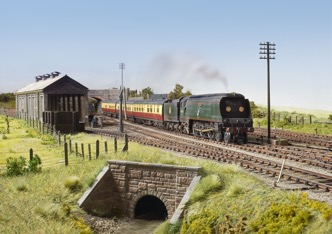North Cornwall in summer 1954
The real St Merryn is a village near Padstow in north Cornwall. It never had a railway though; our model was of a fictitious station which replaced Padstow station as the terminus of the ex-LSWR North Cornwall line. This was done partly in order to give greater modelling scope, but also because the Group did not have sufficient space to build a scale model of Padstow!
We built and exhibited St Merryn over a number of years, and made its final appearance in 2019. We retired it in 2021, and in 2023 a new owner took it under their custody.
The model we exhibited was set in the summer of 1954, a time when the vast majority of the British public took the train to their summer holiday destination.
St Merryn in 1954 would have been on the Southern Region of British Railways and been previously a Southern Railway and originally a London & South Western Railway station.
The station building and goods shed were based on those of Padstow station, as was much of the traffic and rolling stock used. Elements from Ilfracombe and Dorchester could also be recognised by the expert.
Passenger services consisted of Southern Region local trains to and from Okehampton and Exeter, with through coaches to and from London Waterloo; Bodmin is served by Western Region (formerly Great Western Railway) local trains as well as those of the Southern Region. The service pattern is consistent with Padstow at the time. Freight traffic was appropriate to serve the needs of a small town, and was significantly enhanced by the existence of a small harbour served by a rail connection and also by the nearby Royal Naval Air Station (then a training base).
The layout was operated to a sequence which aims to portray typical services and movements on the North Cornwall line, albeit not in the correct proportion of local trains to longer-distance services.
A feature of the real railway was the inefficient (by current standards) usage of rolling stock, whereby strengthening coaches were used on certain trains, for example to cater for schools traffic, but otherwise remained out of use for lengthy periods. The resultant shunting of coaches to and from sidings was replicated on the model.
Another feature of North Cornwall line services was a number of very tight timings between the arrival of one service and departure of the next. This was replicated on the model by the immediate shunting of an arrival to the shunting neck, to permit quick entry of the subsequent departure into the platform road.

